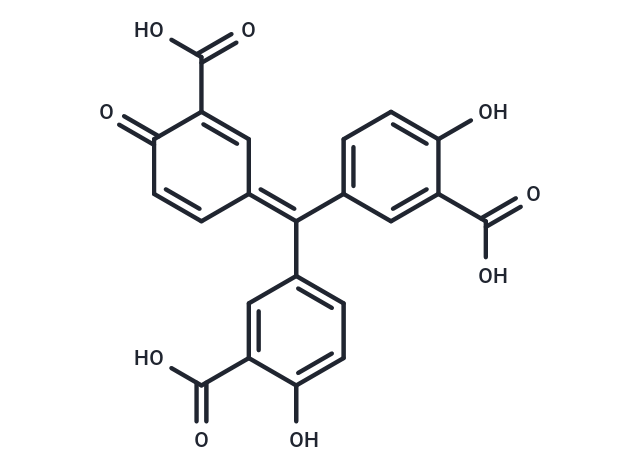Shopping Cart
- Remove All
 Your shopping cart is currently empty
Your shopping cart is currently empty

Aurintricarboxylic acid (NSC-4056) is a strong inhibitor of topoisomerases and other nucleases. It is a potent inhibitor of ribonuclease and topoisomerase II by preventing the binding of the nucleic acid to the enzyme.

| Pack Size | Price | Availability | Quantity |
|---|---|---|---|
| 50 mg | $30 | In Stock | |
| 100 mg | $43 | In Stock | |
| 200 mg | $61 | In Stock | |
| 500 mg | $97 | In Stock | |
| 1 mL x 10 mM (in DMSO) | $48 | In Stock |
| Description | Aurintricarboxylic acid (NSC-4056) is a strong inhibitor of topoisomerases and other nucleases. It is a potent inhibitor of ribonuclease and topoisomerase II by preventing the binding of the nucleic acid to the enzyme. |
| Targets&IC50 | P2X1 (rat):8.6 nM, MicroRNA:0.47 μM, P2X3 (rat):72.9 nM |
| In vitro | Aurintricarboxylic acid (ATA) is a known Stp1 inhibitor with an IC50 of 1.03 μM[1]. |
| Alias | NSC-4056, NSC4056, NSC 4056, ATA |
| Molecular Weight | 422.34 |
| Formula | C22H14O9 |
| Cas No. | 4431-00-9 |
| Smiles | OC(=O)C1=CC(C=CC1=O)=C(c1ccc(O)c(c1)C(O)=O)c1ccc(O)c(c1)C(O)=O |
| Relative Density. | 1.65g/cm3 |
| Storage | Powder: -20°C for 3 years | In solvent: -80°C for 1 year | Shipping with blue ice. | |||||||||||||||||||||||||||||||||||
| Solubility Information | DMSO: 125 mg/mL (295.97 mM), Sonication is recommended. | |||||||||||||||||||||||||||||||||||
Solution Preparation Table | ||||||||||||||||||||||||||||||||||||
DMSO
| ||||||||||||||||||||||||||||||||||||

Copyright © 2015-2025 TargetMol Chemicals Inc. All Rights Reserved.